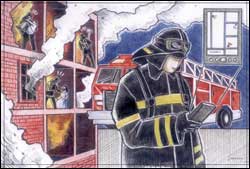
’Smart’ buildings to guide future first responders

The best response to a building emergency is a fast and informed one. The National Institute of Standards and Technology (NIST) is working with the building industry as well as the public safety and information technology communities to achieve both objectives.
NIST researchers are studying how “intelligent” building systems can be used by firefighters, police and other first responders to accurately assess emergency conditions in real-time. One of the biggest problems faced by first responders is a lack of accurate information. Where is the fire within the building? How big is it? Are there flammable chemicals stored nearby?
NIST is working with industry to develop standards to allow manufacturers to create intelligent building systems that use various types of communication networks (including wireless networks) to assist first responders in assessing and mitigating emergencies. The systems would send information such as building floor plans and data from motion, heat, biochemical and other sensors and video cameras directly to fire and police dispatchers who then can communicate detailed information about the scene to first responders.
NIST recently released video presentations that demonstrate how an “Intelligent Building Response” program would work. The videos outline team efforts to create a system of interoperable data content and communications standards that would link first responders with “intelligent” building systems. Firefighters are shown using laptops to track the spread of a developing fire on a floor plan even before reaching the scene. Other real-time building sensor information includes status information concerning a specific building’s mechanical systems, elevators, lighting, security system and fire systems, the locations of building occupants, and temperature and smoke conditions.












